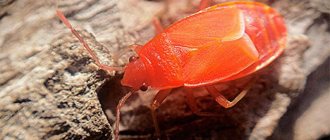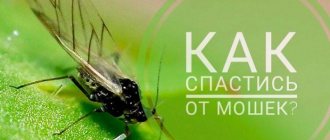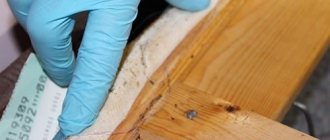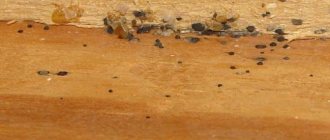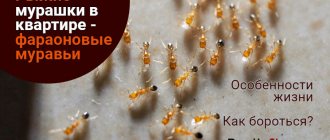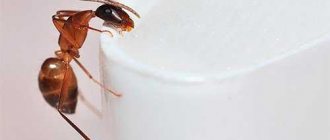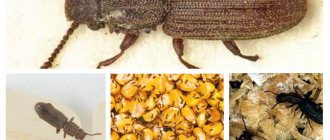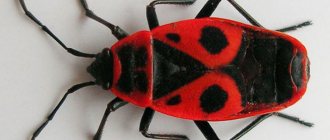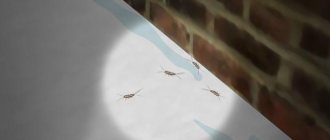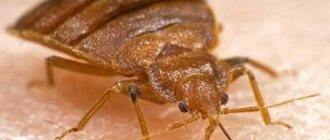The soldier bug, also known as the fireman bug or the Cossack bug, until recently was considered a safe insect, and this is so if the population in the area is insignificant. If there are a lot of such bugs, beets and dill suffer, and lettuce leaves may be damaged. Therefore, there is a need for a ruthless struggle.
Let's look at how to get rid of the soldier bug using chemicals and folk remedies. We will also give brief information on the biological characteristics of the insect.
External differences of the soldier bug
The body of the soldier bug is round, slightly flattened. The insect has a bright color: the body is black, the pronotum and elytra have a red pattern. Bedbugs have no wings. The eyes are red, the mustache and paws are black. The length of the soldiers is 8–11 mm. The oral apparatus is equipped with a piercing-sucking proboscis, which is in a horizontal position.lenslensesadventurenaturetimedicdoc.macro
When eating food, the proboscis tenses and becomes like a needle. With its help, the insect pierces plants and feeds on cell sap.
Red bugs often gather in groups in one place - adults and larvae, which is a distinctive feature of the species. The name “soldiers” comes from the property of being arranged into unique divisions and the colors of the chitinous cover.
Who is often confused with?
The red bug is often confused with two insects:
- Firefighter beetle, soft beetle (Cantharidae). In fact, insects have nothing in common with each other, except for confusion in names. The fire beetle belongs to the order Coleoptera. It has a long body 1–1.5 cm - twice as long as that of the soldier bug. The elytra and tarsi are black, with filamentous whiskers. The mouthparts are gnawing. Insects have wings with which they move through the air. The beetle's abdomen is orange or red.a.koptyrevana_tasha.shgita089
- Blackhead (Corizus hyoscyami).
In appearance, the insects are very similar to each other. The differences are in the position of the head: triangular, slightly tilted, and the shape of the pattern on the back. The eyes are darker than those of the soldier bug - closer to brown. Insects live mainly on umbrella plants: onions, dill. The larvae feed on henbane and tobacco leaves. The henbane bug is very similar to the soldier bug
In England, the soft beetle is called the soldier beetle due to the similarity of its color to the uniform of the royal guards.
Doesn't bite, doesn't fly
Although in fact the soldier is not a beetle, but a bug. And it has many names: there are scientific ones - the common redbug, or the wingless redbug, and there are local ones - Cossack or Moskalik (this is what this bug is called in Ukraine for its bright red color, reminiscent of the caftan of the Moscow archers). So why did this confusion occur and what allowed scientists to attribute the soldier soldier specifically to bedbugs, and not to beetles?
Firstly, bedbugs do not have the pupal development stage that beetles have.
Secondly, these insects have a different structure of the oral apparatus - our soldier, like his other bug relatives, has a piercing-sucking one, but in beetles it is a gnawing one. Thirdly, they also differ in the structure of their wings: beetles have rigid front wing elytra and do not participate in flight - they fly on their hind wings. But bedbugs have a chitinous covering at the ends of the front elytra with membranes, but the back ones (like, for example, the toy soldier) may not have. Therefore, the common red bug does not fly.
Life cycle
The lifespan of the wingless bug is 12–14 months. When living in warm regions, two generations of insects appear, in cold regions - one.
The soldier larva does not have such a bright cover
By the end of August, the soldiers' metabolism slows down, i.e. they are preparing for hibernation - suspended animation. After going to sleep, insects survive due to the nutrients accumulated over the summer period and slow metabolism.
The awakening of bedbugs occurs in March - April, as soon as the sun begins to warm the earth and the first vegetation appears. Some young individuals and females cannot withstand the spring cold and die. In May, adult female bedbugs lay eggs. The process of insect formation takes place in several stages: egg – larva – bug. Newly formed females continue breeding in mid-late June.
Bioindicator
After hatching, the larvae feed on plant juices, preferring young shoots. Their proboscis is more delicate than that of adults, and it cannot pierce anything harder. And if these bugs do not harm agricultural crops, they can cause damage to seedlings of green crops, cabbage and beets.
You can scare soldiers away from the garden using folk remedies: for example, planting black cohosh (cohosh) on the plot or spraying cultivated plantings with an infusion of onion peels, wormwood, and mustard powder.
However, according to biologists, these insects also have benefits.
Tamara Akinshina
What does it eat?
Soldier bugs feed on seeds, juice of plants and fruits, and the remains of other insects. They get food closer to the ground; they will climb a tall tree only as a last resort. In the absence of sufficient food, bedbugs feed on weeds and even their own relatives.
Red bugs have a powerful proboscis that can pierce fairly hard shoots and plant seeds. Insects are not capable of harming humans. The proboscis cannot pierce the skin of an adult or child.
Small larvae feed only on the sap of young shoots. The mouthparts are not fully developed, and insects are not able to pierce other plants.
Soldier bugs, like all representatives of the species, have odorous glands. In adult insects they are located on the chest, in larvae - on the abdomen closer to the dorsal part.
Last resort
Well, one last thing. If everything has been tried, and annoying enemies appear here and there, you can resort to a radical solution and use special chemicals - insecticides. One of the most common is Karbofos, which can be purchased at a store for summer residents. Follow the instructions, pour the solution over the infected areas and corners in the room and you can relax - insects will not be safe.
There is another option - Bankol. It instantly destroys soldier bugs, and other insects too, if necessary. Sinuzan, Sichlor and others are no less effective. But before you buy them, make sure that you are not allergic to these drugs. And, of course, keep them away from children. Have a good fight!
Where is it distributed?
The soldier bug is widespread throughout Eurasia, northern Africa and the United States. Countries with a temperate climate are favorable for insect reproduction.
Bedbug habitat:
- under the bark of trees;
- on stumps;
- in piles of dry grass and leaves;
- at the foundations of houses, baths, gazebos and other outbuildings;
- in the fence and its foundation.
kath_gruendisorder_vortexentomologist_arina
During hibernation, insects are found under heaps of garbage, in humus, in trees - under the bark or in hollows.
What harm do insects and their larvae cause?
Usually the soldiers appear as soon as the sun melts patches of snow to the ground, but here and there there is still crust, and in the thawed patch the soldiers are already scurrying around, huddled together. The primary habitat of the soldier is Eurasia, and the European continent is most preferable for him.
Usually the larvae rush to young plants, the shoots of which have just emerged from the buds, are tender and full of delicious juice. The proboscis pierces the tissue, permanently distorting the growths and sometimes causing them to dry out completely. Why do they feed on the juice of young shoots? Because their proboscis is still very weak and is only suitable for piercing only the most delicate part of the plant.
Some time ago, the soldier bug was not considered a harmful insect at all: it crawled and crawled on its own, without bothering anyone. But science, studying an increasing number of plants, insects and animals, got to him and delivered a verdict - guilty!
With soldiers, everything ends up the same as with aphids, the leaves become bent, the shoots stop growing. Photosynthesis decreases, the plant’s consumption of nutrients is reduced, hence the reduction in yield. It often happens that plants attacked by hordes of beetles simply die. And fruits and berries, speckled with bites from such insects, look, to say the least, not at all attractive.
Grape plantings are at particular risk, and, by the way, these bugs are seen there most often. The strength and durability of the soldiers' proboscis is quite enough to pierce the grape stems and the fruits themselves, turning them into something wrinkled and completely unattractive. You need to constantly fight soldier bugs, and now we will tell you how.
How does it reproduce
Insects reproduce rapidly during the spring and summer. In warm regions, bedbugs produce two generations from May to July. The colony quickly increases in size and, when living on the site, rapidly “attacks” cultivated plants.
When mating, the male and female are attached to each other by the rear parts of their bodies. Insects can remain in this position from one to two hours to several days. After the seed cells enter the female’s body, the bugs separate.cora_jones_wild1752koreneva_irina23medvebooks
The female lays eggs in habitats, on plant leaves or in such a place that it is easier for the larvae to get food. The clutch can consist of 16–30 white eggs, shaped like grains of rice. On the top of the eggs, peculiar caps are formed, through which the larvae appear - after seven to ten days.lilabums
Young individuals can remain motionless for a long time, feeding on the sap of the plants on which they are located. In appearance, they differ from adult insects not only in their small size. The larvae are completely red, without black inclusions.
What kind of life does the wingless red bug have?
Toy soldiers are terrestrial representatives of the family. They are one of the first to wake up after hibernation. Already in March, as soon as the snow melts, they can be seen at the base of linden trees. Red bugs have no natural enemies, so they do not hide and lead an open lifestyle.
The bright red color of insects warns predators of their unpleasant taste, so the soldier bug is reliably protected from predatory insects and birds.
Insects are active from March to September-October; with the first frost they go into hibernation. In winter, soldiers hide under the bark of trees, in the cracks of stumps and under piles of leaves.
Insects live in colonies. At the beginning of summer they have a small number, but by the end of autumn the colony can number tens of thousands of individuals.
The lifespan of bedbugs and their fertility may vary depending on living conditions. Temperature has a particularly noticeable effect.
What do soldiers eat?
They have a mixed type of nutrition. Insects suck the juice from plants, fruits and seeds that have fallen to the ground. Larvae and adults feed on organic debris, in particular, the corpses of invertebrates.
The diet of wingless red bugs includes dead insects - beetle larvae, wasps, aphids. Soldiers take the main part of their food from the ground; they can also climb plants.
Soldiers are absolutely safe for humans and pets.
Soldier bug: reproduction
Reproduction of soldier bugs
A feature of these insects is incomplete metamorphosis, i.e., there is no pupal stage in their life cycle. In the spring, the soldiers mate. In each colony there are 2-3 times more males than females. To reproduce, males are attached with their bellies to females and in a clutch, with their backs to each other, move around for several hours and even days.
The copulation process lasts so long (from 0.5 to 7 days) because this is a mechanism for protecting the male’s ejaculate in conditions of fierce competition.
The female lays eggs in the ground or under a layer of dead plants. The eggs of soldier bugs are oval in shape and white translucent in color. The female lays about 20-30 eggs.
Embryonic development lasts 1-1.5 weeks under normal conditions. If the temperature is below +18°C, then this phase can last up to 3.5 weeks. At the end of this period, the eggs change color and become yellow-red.
In low temperature conditions, the eggs decrease in size, and therefore the larvae from them emerge small. Such larvae often become prey to larger relatives.
In total, the larvae go through 5 stages. They can take 17-24 days to mature. If the temperature drops below +14-15°C, then the nymphs stop feeding and, therefore, stop developing. In appearance they are similar to adults, but the larvae do not have elytra.
In the northern regions, one generation changes per year, and in the southern regions, two. Nymphs that appear in May become sexually mature in June and begin to mate and reproduce. In autumn, adults of the second generation leave for the winter.
Reasons for appearance
The main reasons for the appearance of soldier bugs on the site include:
- rotten stumps in the garden;
- dried plants;
- piles of dry garbage and leaves;
- a large number of weeds, especially quinoa and wormwood;
- legumes;
- woodpiles;
- alfalfa in your or neighbors’ garden;
- growing carrots, cabbage, beets, and currants on the plot.
Insects especially love alfalfa. To get rid of the larvae, you need to pull out the weed along with the roots and burn it.
All gardeners have the soldier bug
The insects often nest in legumes and alfalfa to survive the winter cold.
In some cases, bedbugs may appear in an apartment, more often in a private house. If you have indoor flowers, seedlings or other vegetation, insects will multiply very quickly. There is a tendency that when one soldier appears, other relatives come running after him. In the absence of food, they die or go to other places.
Distinctive characteristics
The soldier bug is not the only name for this bug. Due to its unusual coloring (patterns, spots with black dots on a red background), it is also called a fireman. And the absence of hind wings explains the third name - wingless red bug.
The soldier bug looks like an ordinary ground bug with a characteristic pattern on its back.
Please note: the wings are yellow, but the pattern is always the same.
The size of the bug does not exceed 8-10 mm, and the body has a round, slightly flattened shape. Instead of a mouth, the soldier has a kind of proboscis.
However, only a description of the appearance cannot give a complete description of this bug. It’s not for nothing that they call it a harbinger of spring, because bedbugs with a red back and black stripes are among the first to emerge from their shelters after the winter cold.
Insects carry out their life activities in groups.
Small colonies of firebugs are found in various places:
- near fallen trees.
- Along the fences.
- In woodpiles with firewood.
- Etc.
Striped bugs always cluster on an open surface as close to sunlight as possible.
Bedbugs prepare thoroughly for hibernation, which lasts all winter, by selecting dry cracks in fences, old houses, and tree trunks in advance.
The soldier bug is visually very similar to the firefighter beetle.
Insects can be distinguished by the following characteristics:
- body shape (in a beetle it is more elongated).
- A specific aroma characteristic of bedbugs.
- The ability to fly, which the fire beetle boasts.
The latter protects the plantings from pests, which include the wingless red bug. This type of bed bug appears extremely rarely in an apartment.
How to fight insects
When pests appear, it is necessary to immediately take measures to destroy them. Insects reproduce quickly and can cause considerable damage to garden crops. There are different methods to get rid of the soldier bug.
Natural enemies
The natural enemies of soldier bugs are birds, mantises and bats. A pungent odor can scare off certain birds, such as tits. Sparrows are good at destroying insects, but they can also harm crop plants. When red bugs get caught in a web, many spiders discard them due to the pungent odor.
Its poisonous color and smell make it invulnerable
The coloring of the red bug is a camouflage with which it protects itself from natural enemies. For birds and spiders, red is a signal that the insect is poisonous and should not be eaten. Soldier bugs are well protected from destruction precisely due to this property.
Chemicals
When using chemicals, it is necessary to take into account that when insects are killed, harm will be caused to the soil and the plants themselves. Soldier bugs have the ability to adapt to pesticides, so each subsequent generation does not die from the previously used poison.
Methods for getting rid of soldier bugs:
- independent processing of the site. In this case, you must carefully read the instructions to comply with the indicated dosages, processing times and precautions. Karbofos, Malathion and Aktara are used as poisons, which cause paralysis of insects. The powder drug “Bankol” effectively destroys soldiers. For use, the product is diluted in water. The pesticide is considered to be of low toxicity to plants, soil and people; mir_zelenyi89succulentia.ru
- professional disinfestation. Experts will select a product taking into account the characteristics of the soil. This type of treatment is especially recommended for large areas. The advantage of turning to disinfectants is the comprehensive destruction of various types of pests.
In a house or apartment, soldier bugs can be destroyed using regular Dichlorvos.
Light traps
Light traps are used to catch insects. With their help, you can reduce the population of soldier bugs, but they cannot be completely eradicated. Most often, males and unfertilized females fall into them.
There are many types of traps, and you can easily buy the most suitable one in stores. The operating principle depends on the type of light emitted:
- ordinary light is visible radiation. Pests crawl into the light and stick to the adhesive surface or are sucked in by the built-in fan;
- ultraviolet light is invisible to humans. An insect attracted by radiation is killed by the electrical grid.
ultraviolet lightlight trap
Various powders and agents are added to some types of traps that impede the movement of bedbugs or paralyze them, as a result of which the insect dies.
Traditional methods
To destroy soldier bugs, you can use traditional methods that will not cause any harm to cultivated plants and soil.
The following means are used to control insects:
- Onion peel. Pour the husks halfway into a large container and fill with cold water. Leave for 5-6 days. Strain the finished infusion and treat the plants on the site with it.
- Soap solution. Grate 300 g of laundry soap onto ten liters of water on a coarse grater. Treat the plants with the prepared solution. It is not recommended to increase the amount of soap.
- Mustard powder. To process 1 sq. m of plot is needed for 10–12 liters. add 100 g of powder to water. Leave the solution for 1.5–2 hours. Treatment can be carried out once every 10–14 days.
- Wood ash. Dilute 200 g of product into a bucket of water. Using wood ash you can not only kill insects. The natural product is beneficial for the soil - it enriches it with potassium.
- Hunting belts. Special windings are attached to tree trunks, onto which poisonous or sticky substances are applied that restrict the movements of insects. They can be formed in the form of funnels and bowls equipped with containers.
- Manual assembly.
Soldier bugs move quickly, so collecting them will not be easy. Use shovels to shovel large accumulations into prepared containers for disposal. Squash single insects directly on plants, like Colorado potato beetles. Traditional methods of control will help repel pests
When soldier bugs enter a living space, they are destroyed using kerosene or vinegar. To do this, treat baseboards, furniture legs, and plinths with the product. To catch single representatives, you can lay out sticky strips - Velcro - on the floor.
Now in the heat, now in the cold
The most accessible method of controlling insects is boiling water. Toy soldiers are no exception. Pour boiling water over the places where they accumulate, especially those that are darkened. If there are few soldiers, this will help. What to do in winter?
Oddly enough, it is even easier to get rid of soldier beetles in the house in winter, because in the wild they live exclusively in warm tropical places, so even small changes in temperature are very unfavorable for them. Ventilate the room by opening the windows wide for several hours. No one from the colony will survive, you can be sure.
Why is the soldier bug harmful?
Soldier bugs are far from harmless animals, as is commonly believed. They feed not only on seeds and remains of dead insects. Pests suck the juice from young shoots, leaves, and fruits, causing great damage to garden crops.
Damage caused by firebugs:
- they like to suck the juice from grape fruits, as a result, the yield of the bushes is significantly reduced. Damaged berries become unsuitable for food;
- The insect's proboscis is quite powerful, so it can pierce hard seeds and thick shoots. The plant from which bugs suck out beneficial juices gradually stops blooming, bearing fruit and dies;
- affects tree trunks and branches;
- damages cabbage and beet leaves, leaving small punctures on them;
- destroy seeds sown in the soil;
- are dangerous pests for emerging seedlings. The bugs suck out the nutritious juice, causing the sprouts to dry out.
Fire bugs cause harm when there are a lot of them
A large colony of insects can cause significant damage to summer cottages, farms and vineyards.
Pest recognition methods
The presence of a bedbug in an area can be determined by the presence of adults, clutches of eggs and larvae. The fight against an unpleasant neighborhood should begin with differentiating the pest from other species, many of which are useful to the gardener. Therefore, you need to study the soldier bug.
Top cover:
- orange with black pattern;
- sometimes yellow with the same ornament may be found;
- greenish yellow.
The description of the soldier bug is a bit like a beetle. But the beetle has an oblong, convex body, and the bug has an oval and flattened body. They can be distinguished by what the bugs eat and what the fireman beetle eats.
Knowing for sure what soldier bugs look like, that insects cannot fly at all, while the fireman beetle, although not very similar in appearance to a hemipteran pest, flies, albeit rather slowly, then there is not even a particular need to look at what the bug eats in order to do not confuse it with flying beetles, which bring undoubted benefits.
Bedbugs have quite characteristic differences to differentiate them:
- bright color with black spots;
- oval and flattened body;
- the presence on plants of clusters of eggs and larvae drinking juices from the leaves;
- characteristic marks on garden crops left after they have been saturated;
- death of individual plants that cannot tolerate the damage caused to them;
- traces of vital activity with a characteristic unpleasant odor.
Damaged cabbage leaf by the wingless red bug The damage that a cute and bright insect, completely harmless and ordinary in appearance, which everyone admired while observing in the green grass, can cause to a lovingly grown crop, causes only one thought to an experienced gardener or gardener: this is a soldier bug, like get rid?
Preventive methods
To prevent the appearance of soldier bugs, you can take the following measures:
- Planting on a cohosh plot. Translated from Latin, the plant is called black cohosh. The smell of flowers repels insects, and they try to immigrate away from it. It is convenient to plant the plant around the perimeter of the site. You can also use other plants: wormwood, mustard.
- Plant grape bushes and other cultivated plants away from alfalfa and legumes, which are especially loved by soldier bugs.
- Destruction of weeds on the site. Weed your garden in a timely manner. As the grass grows, the number of pests increases, as does the number of eggs laid. If possible, burn the grass as there may be larvae on the leaves.
- If there is a lawn on the site, the height of the grass should be as minimal as the type of cover allows.
- Do not leave heaps of garbage or fallen leaves on the site - the favorite habitats of red bugs.
- If there are rotten and old stumps, it is necessary to uproot them and burn them.
Soldier bugs reproduce quickly and can cause significant damage to cultivated plants. At the same time, they have a thin chitinous cover and a poorly developed nervous system, so they are easy to destroy. Carrying out preventive measures will protect the area from insect infestation.
Source
Prevention
It is enough to follow a number of rules to prevent the invasion of soldier beetles in your garden or summer cottage. For example:
- Soldier beetles love legumes and alfalfa, so it is better to plant them in a separate area.
- Alfalfa and weeds must be mowed so that no stems remain (at the root).
- It is better to burn the remaining weeds, if any.
- Do not allow rotting wood to remain on the site.
- It is better to treat the trunks of fruit and berry crops with lime, and dig up the root zone well.
- You should not get carried away with excessive fertilization of the soil on the site.
The soldier beetle is not a common pest, but under certain conditions, it can harm the future harvest. Bed bugs attack young shoots and plants more, so it is advisable to take a number of actions to prevent these pests, and others, from appearing on the site. There are pests that cause much more serious damage. In any case, it is necessary to take care of the future harvest, since a lot of work is put into it.
Soldier bug. In excellent quality. Full HD 1080p
If you have to endure living next to a neighbor who loves alfalfa and prefers a Moorish lawn to a chaise longue in the middle of a Russian field, then at least mow the weeds as low and close to the fence as possible, and then collect the mowed grass and burn it. There may be both ovipositor and bug larvae on the grass. Do not allow this to happen on your property; if there is a lawn, it must be cut to the minimum permitted height.
Before planting young plants on a plot of, say, the same seedlings, protect it as much as possible from attacks by bedbugs - remove all weeds, loosen the soil and destroy wormwood, quinoa and acorn grass on the plot, in this case they will not repel bedbugs, but, on the contrary, will attract them!
